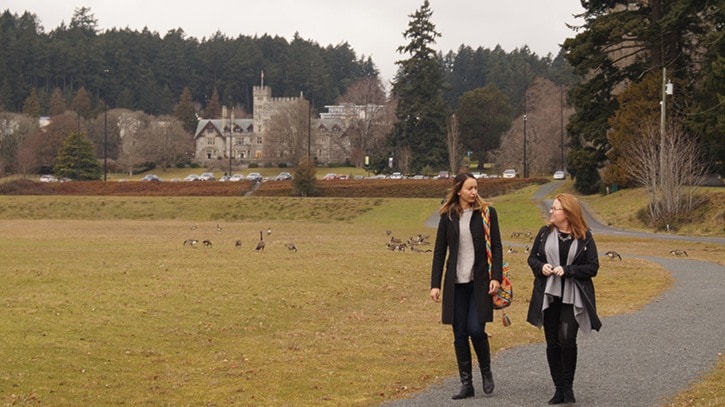The lawyer representing Songhees First Nation expects that within a year they will be deep into a treaty process that includes the Department of National Defence property that houses Royal Roads University.
“If we’re not, then from our perspective that raises real questions about the federal government’s commitment to the treaty process,” said Robert Janes, who also represents Beecher Bay First Nation.
It was around 1996 when the band first expressed interest in the property – “Which is about the same time that the military brass said that they no longer wanted it,” Janes noted – but the land still isn’t in the treaty process and can’t be until it is declared surplus by DND. That remains an ongoing process and is where the item currently sits.
Having the land go through the treaty process, as opposed to a fee simple acquisition or having it added as reserve land, means that it won’t be subject to Colwood or Capital Regional District bylaws.
Esquimalt Nation has also been brought into the process in the hopes of making this a co-operative initiative between both bands. The property, because it is across from Esquimalt Harbour and well detached from Songhees First Nation’s reserve lands, isn’t ideal for the band but their options are few, Janes explained.
“First Nations have been told, if they go into treaty, there’s a whole list of things that they can’t have. They can’t have private property, they can’t have Crown land that the Crown wants to use for other purposes … there are very limited pieces of land that are available.”
The news that the DND could dispose of the property has been met with concern from some Colwood residents. The university will not be affected by any shift in ownership, but it remains unclear what could become of the well-used trails and green space that encircle the institution.
At its Jan. 23 meeting, Colwood council heard from resident and former city councillor Judith Cullington, who was representing the “Royal Roads Group.” Cullington opened by acknowledging they were located on the traditional lands of Songhees and Esquimalt First Nation before explaining the group’s intention.
“We’re not trying to stop the land transfer. We’re trying to give the community a voice in this process,” she said.
She hopes that Colwood could have a say in where any future development might happen and wants the city to collectively decide where the best and worst places would be for development. She also encouraged council and staff to get involved in that process.
“This has the potential to be a very significant change for our city and we all need to be working together,” Cullington said.
Mayor Carol Hamilton said the City has representatives in attendance during negotiations between the DND and First Nations groups, but she noted they are unable to disclose what those negotiations have entailed.
She added that the recent $21.5-million investment announcement for the university, which includes funding from both the provincial and federal governments, was a positive sign.
“That gives confidence that that’s still a very important commodity and amenity for the lands there,” she said.
Last week, Royal Roads University president Allan Cahoon told the Gazette that they are willing to work with First Nations and the federal government and that they appreciate their support for the school’s continuance.
“We’re not fearful and we’re supporting what’s going on,” he said.
Janes hopes any eventual development on the land can be done in a fashion that will keep everybody happy.
“Royal Roads is an important and very complicated piece of land that’s got a lot of historic significance. It’s something that people all over Victoria have an interest in,” he said.
“Our approach, and I think Colwood has the same mind, is that we’d like to work co-operatively with (them) to find something that works for both sides.
“We think there’s lots of ways in which protection of the area over there and the accommodation of some sensible development can be achieved.”
